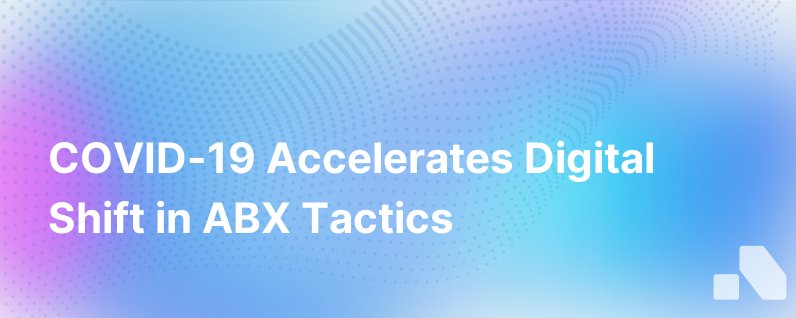
The onset of the COVID-19 pandemic radically altered the business landscape, accelerating digital transformation in a way that has dramatically reshaped account-based experience (ABX) strategies. The forced pivot to remote work, e-commerce, and online communication prompted businesses of all sizes to reassess and adjust their operations. This change was not a mere adjustment, but rather an evolution into an intensely digital-centric world that businesses are now navigating.
One key aspect of this transformation has been the increased reliance on and sophistication of account-based experience (ABX) strategies. ABX, an evolution of account-based marketing (ABM), takes a more holistic view by considering the full spectrum of customer interactions and personalization at scale to improve the experience across the customer journey.
Let us delve into a nuanced exploration of how the COVID-19 pandemic fast-tracked the digital shift, emphasizing evolving ABX strategies.
The Acceleration of Digital Adoption
Before the pandemic, companies were certainly already moving towards a digital future. However, the urgency to digitize was incredibly rapid once physical meetings became untenable, and face-to-face sales tactics ground to a halt.
Each customer touchpoint had to be reimagined within the constraints imposed by the pandemic. Video conferencing replaced in-person meetings. Cloud-based collaboration became mandatory. AI-powered tools for data analytics, customer support, and even networking grew exponentially in use. The pandemic didn't just induce a shift to digital; it demanded a reconfiguration of business strategies to survive a contactless economy.
Rethink, Retool, and Revitalize: ABX Strategies in a Post-Pandemic World
The increased digitization opened the door to more data-driven engagements and pulled ABX to the forefront. Here’s how the digital acceleration spurred by COVID-19 led to more robust ABX strategies:
Enhanced Data Utilization
With entire workforces and customer bases operating online, businesses have access to richer data streams. These inputs are crucial for ABX, allowing companies to map out an account’s digital footprint for more personalized interaction strategies.
Virtual Selling Becomes the Norm
The idea of virtual selling moved from a future possibility to the standard mode of operation. This elevated the demand for digital literacy and sales tools that can facilitate online negotiations, presentations, and account management, all constituent parts of an effective ABX strategy.
Digital Content Takes Center Stage
With the challenge of engaging prospects in a virtual world, content became a more significant part of the ABX arsenal. Organizations needed targeted content that could address specific account pain points, reinforcing how critical an informed content strategy is to ABX.
Increased Demand for Personalization
Personalized experiences are no longer nice-to-have; they became crucial for standing out in a crowded and exclusively digital marketplace. ABX strategies had to innovate methods to deliver individualized engagement at scale.
Integration of Sales and Marketing
Remote collaboration tools saw an unprecedented uptick in adoption, enabling better sales and marketing alignment—a core tenet of ABX. These teams could work together seamlessly in the digital environment, honing their joint strategies.
Accelerated Adoption of AI and ML
Artificial intelligence (AI) and machine learning (ML) technologies became instrumental in processing large volumes of data for actionable insights. These technologies support ABX by helping to predict customer needs and behaviors, enabling sophisticated account targeting.
Digital Customer Experiences
Across the board, the focus shifted to creating holistic, end-to-end digital experiences, heightened in ABX strategies. From initial prospecting through to sale and post-sale support, businesses worked to ensure seamless, high-quality digital interactions.
Innovation in Engagement Platforms
The need for new ways to connect lead to innovations in engagement platforms, pushing ABX strategies to leverage tools like virtual events, webinars, and online communities to create meaningful connections in a socially-distanced world.
Rise of E-commerce and Digital Solutions
For many businesses, the pandemic necessitated the development or enhancement of their e-commerce capabilities, which naturally dovetailed with ABX's emphasis on optimized digital engagement.
Adaptation to Changing Customer Behaviors
With consumers and businesses becoming more digitally savvy and comfortable online, ABX strategies evolved to meet these changing expectations and behaviors, further personalizing and refining their approaches.
Larger Implications for Businesses
The COVID-induced digital shift meant that companies had to recalibrate their value propositions, articulating how they could serve customers in a changed world. This also redefined metrics of success with an increased focus on digital engagement signals and outcomes.
Implementing Cutting-Edge ABX Strategies with Aomni
In the pursuit of optimized ABX strategies, Aomni can bridge the gap between meeting modern business needs and the functional capabilities required to thrive in a post-pandemic world. With AI-based tools, real-time account research, competitive insights, and personalized sales content, Aomni catalyzes the digital shift, streamlining the processes that would generally take enormous effort and resources.
As businesses embark on the ABX journey in a post-COVID era, Aomni proves to be the silent orchestrator, enhancing the digital sales experience and propelling enterprises into a new age of customer engagement and satisfaction.
The COVID-19 pandemic has undoubtedly served as a fierce catalyst for the digital revolution, coalescing around ABX strategies as vital linchpins for sustained business success in the future. As companies navigate these unprecedented times, Aomni can empower sales teams to harness the momentum of the digital shift and drive transformational growth for a new business paradigm.